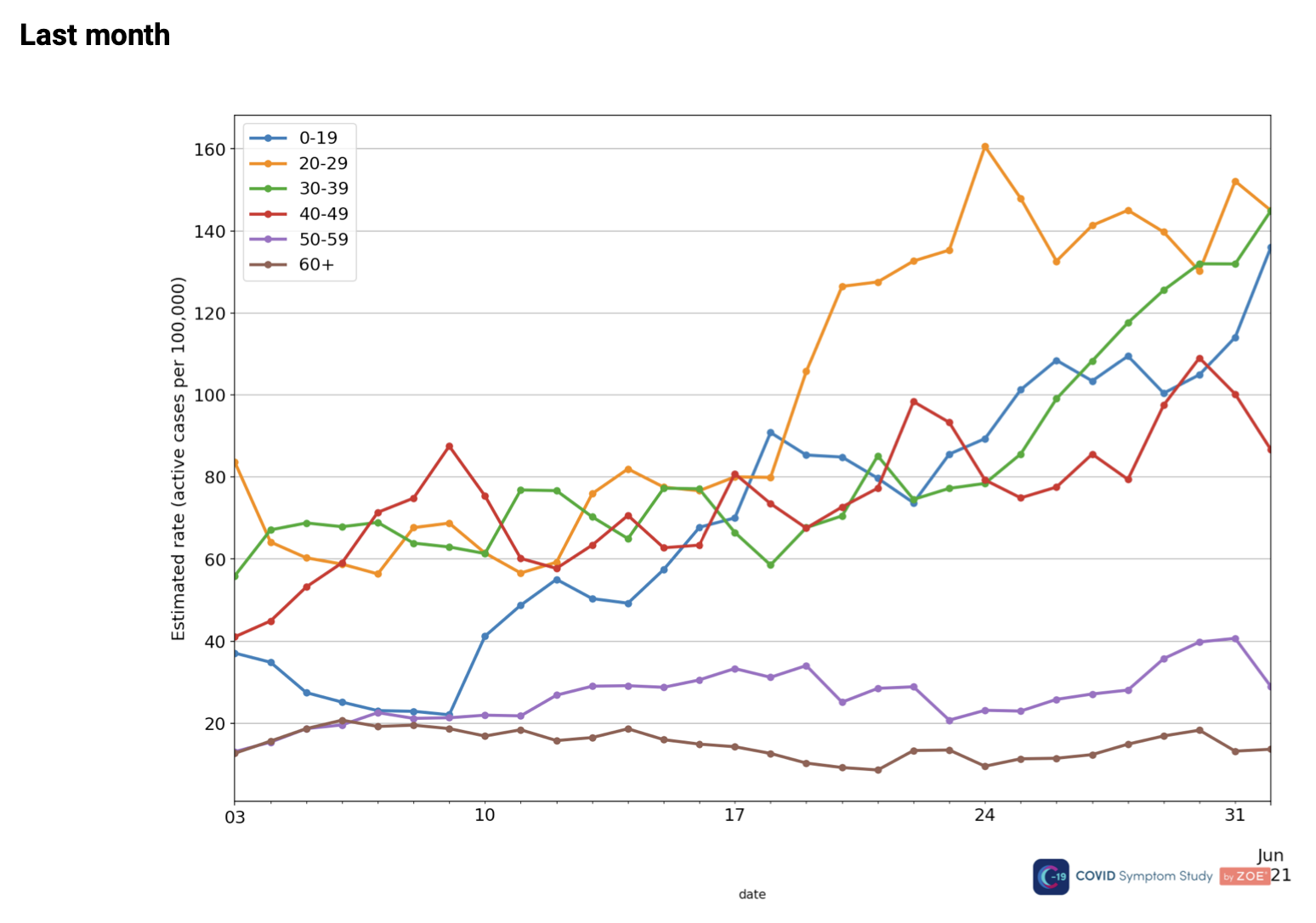
Has a wave started in the young?
June 3, 2021

This article has not been updated recently
According to ZOE COVID Study figures, it is estimated there are currently 4,608 new symptomatic cases of COVID in the UK on average, based on swab test data from up to five days ago [*]. This compares to 2,550 daily cases a week ago, an increase of 80%.
In terms of prevalence, on average 1 in 1,090 people in the UK currently have symptomatic COVID [1].
The UK R value is 1.1 and regional R values are; England, 1.1, Wales, 0.9, Scotland, 1.2 (full table of regional results below).
According to the incidence data, there are currently 10 times more cases in the under 40s than in the over 60s (see full graph below).
According to our data, a small proportion of those who have been vaccinated still get infected. ZOE collected reports this week from 123 contributors who had an infection after two doses of the vaccine, and 123 who reported an infection after one dose. The following approximate risk factors for infection based on one, two or zero doses of the vaccination, have been recorded using the latest ZOE data:
- Current risk of new daily COVID infection
- in the unvaccinated: 1 in 6,710
- after 1 vaccine dose: 1 in 14,503
- after 2 vaccine doses : 1 in 34,583
The ZOE COVID Study incidence figures (new symptomatic cases) are based on around one million weekly reporters and the proportion of newly symptomatic users who have received positive swab tests. The latest survey figures were based on data from 6,639 recent swab tests done between 16 to 29 May 2021. The data excludes the lateral flow tests.
ZOE COVID Study hotspot detection table - worst performing regions

Tim Spector OBE, lead scientist on the ZOE COVID Study app and Professor of Genetic Epidemiology at King’s College London, comments on the latest data:
“The UK picture is changing quickly now. Cases are rising, but not nationwide, it’s very much a regional issue. The North West of England and Scotland are the two regions with the highest prevalence, with rates higher than in some parts of Europe. However, the data highlights that the increase is happening in the younger age groups, suggesting the start of an epidemic in the young. We can’t be too complacent, and we are monitoring things closely.
The ending of lockdown is on everyone's minds and given the current situation, I believe we should continue to soften restrictions but not lift them all just yet. While unlikely, it’s too early to tell if these increases are going to have any impact on hospital admissions or death rate. The government said it would use data, not dates to make key decisions. It’s sensible to continue measures like working from home as transmission rates are very high in offices, not to mention the impact of increased use of public transport. I’d also recommend we keep wearing masks on public transport and reduce overcrowding indoors. What’s really important moving forward is having the flexibility to deal with local outbreaks while letting the rest of the country and economy get back to normal at the same time.”
The app is delivered in collaboration with King’s Health Partners, an Academic Health Sciences Centre based in South East London.
Incidence (daily new symptomatic cases)[*], R values and prevalence regional breakdown table

The ZOE COVID Symptom Study UK Infection Survey results over time

Map of UK prevalence figures

Daily active cases by nation

Daily prevalence rates by age group












.png)


.jpg)














.png)







%202.png)
.png)


















.png)




%20(1).png)


